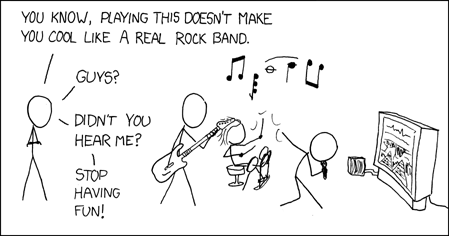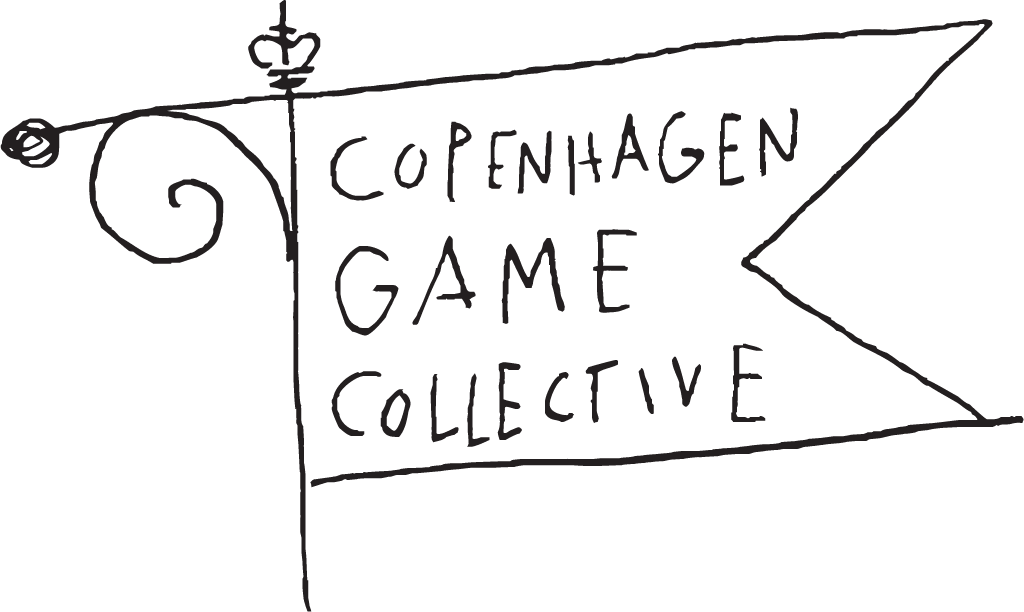Gestural Gameplay, The Right Way (Part 1)
So, we just submitted grant applications (to both DFI’s New Danish Screen and Nordic Game’s Development Support) to fund the continued development of Face-off in the Magic Circle. Wish us luck!
[singlepic id=11 w=400 float=none]
In our application(s), we argued that Face-off is not just a promising design idea, but also a promising business idea. Make no mistake; the idea of getting players to look at each other is not simply innovation for innovation sake. We believe that Face-off could offer exactly the kind of gameplay experience that Wii owners have been craving.
Yes, for real. This isn’t just some marketing shill. Here’s the argument:
Gestural Gameplay
With the release of the Nintendo Wii in 2006, the popularity of gestural gameplay has skyrocketed. Touchstone titles like Wii Sports (2006) and Wii Fit (2008) – two of the best-selling videogames of all time – have thrived on intuitive controls and satisfyingly physical gameplay (and, of course, good marketing).
And yet, Wii Sports and Wii Fit aside, surprisingly few other Wii games have successfully embraced the possibilities of these new gameplay opportunities. Several Wii games from some of Nintendo’s most storied franchises (e.g. Super Smash Bros. Brawl, 2008) support only Gamecube-style controller-based gameplay.
Other titles, such as Mario Kart Wii (2008) and Punch-Out!! (2009), offer gestural controls, but only do so half-heartedly. In both games, players can opt to play with a traditional controller. The problem with designing games for multiple control modalities is that gestural control becomes superfluous; when the novelty value of the interface wears off, these kinds of gestures feel unnecessary and frustratingly imprecise. As Chris Kohle of Wired writes in his review of Punch-Out!!: “standard button controls are the way to go for a game that demands such precision.”
In short, the majority of Wii titles have failed to do more than just awkwardly layer clumsy gestures over actions originally designed for button presses and thumbstick control. As Matt Wales of IGN UK remarks: “Even now, it’s rare to find a third-party title that attempts to use motion-controls in any meaningful way.”
This absence has created a palpable demand for new titles that fulfill Nintendo’s promise of a new era of gestural, physical gameplay.
Social Gameplay
A second defining feature of the Wii’s cultural zeitgeist is Nintendo’s vision of “social” gaming. Through both its marketing campaigns and its intentionally simple, family-friendly games, Nintendo has created the expectation that the Wii should be played together. Look at almost any of Nintendo’s advertisement and you’ll see that the players themselves are featured as much or even more than the graphics on the television screen. Apart from just Nintendo, blockbuster titles like Sing Star (2004) and Rock Band (2007) have taken advantage of this renewed interest in social game, and Microsoft’s upcoming “Project Natal” aims to capitalize on the trend as well.
Still, despite the various successes of these projects, all of them overlook certain key modalities of human communication and social interchange. In particular, most so-called “social” videogames chain players to the television screen. Just think back to the last Rock Band or Guitar Hero party you attended; in our experience, players of these games tend to fixate on the screen rather than on each other or on their audience. The screen can become a kind of tyrant, demanding the attention of players and spectators alike. Far from instigating any kind of meaningful player-player interchange, it’s a setup that can suck the social energy right out of the room.

But whether or not you share our opinions on Rock Band, our argument is ultimately this: when players are forced to look at the screen rather than at each other, they miss out on all the rich emotion and information encoded in human facial expressions.
Face-off in the Magic Circle aims to explore this terrain, combining the face-to-face interactions of traditional playground games with the computational power and multimedia capabilities of console machines. Furthermore, unlike the similarly spirited “augmented reality” games developed in research labs, Face-off does not require a specialized hardware setup, and instead takes advantage of the already familiar environment of the console-enabled living room.
This design vision actually comes from our work on Dark Room Sex Game, our cooperative no-graphics erotic game. If you watch that players tend to look at each other – both because they need to coordinate, but also because there is nothing else to really look at. Indeed, this eye contact makes the whole experience all the more embarrassing (which was really the whole point). Embarrassment aside, we also realized that face-to-face gameplay can be deeply engaging even in a traditionally screen-based context.
Fantasy Play
Fantasy has always been a cornerstone of play. In recent decades, fantasy play has drawn considerable inspiration from cultural juggernauts like George Lucas’ Star Wars and J.K. Rowling’s Harry Potter series. Consider the countless children (and adults!), for example, who have staged pretend lightsaber fights and wizard duels in their backyard.
Search YouTube, and you’ll find scores upon scores of imitation scenes – many of which employ elaborate post-production effects. Note also that the vast majority of these staged vignettes center around the kind of dramatic face-to-face showdowns that the films so often depict.
So, when the Wii was first announced, popular notions of virtual reality set player expectations for what the Wiimote would make possible – for instance, the ability to engage in sword combat or spell-casting through “real” body movements. Yet, for both technical and design reasons, the games themselves have fallen short of this promise.
In terms of wizard games, Electronic Arts has released two Harry Potter titles for the Wii, with mixed results. Gestural control does make the games feel more immersive; as Aaron Thomas of GameSpot remarks, “it makes it feel as if you are actually casting spells, which goes a long way toward making the game more enjoyable.” But reviewers across the board agree that both games suffer from repetitive, depthless gameplay. In his review of Harry Potter and the Half-Blood Prince, Tom McShea of GameSpot points out that the duels “often boil down to one cheap tactic,” limiting “the long-term appeal of this mode.” No small surprise, then, that McShea ultimately concludes: “The Half-Blood Prince squanders its impressive license; you’re better off reading the book again.”
We can only wonder why EA didn’t spend more effort on designing a balanced, replayable dueling mode – especially given that dueling was perhaps the game’s most anticipated feature. Surely, the fantasy elements that have made the books so popular do not reside in running fetch quests and collecting “Hogwarts Crests.”
Tellingly, the marketing campaign around the games takes quite a different approach. In one television advert, two robe-toting children square off on an empty playground, face-to-face, Wild West style. Armed with his trusty Wiimote, the smaller of the two yells “Levicorpus!” and effectively dangles his opponent in the air, upside-down. Of course, the Wiimote can’t actually move people (…yet); but we assert that it is possible to design a game that comes several steps closer to creating such a fantasy scenario.
It’s clear to us – from the countless fan videos, from EA’s own marketing campaign, and from our own imaginations – that the lasting image of the Harry Potter series is indeed the Harry-Voldemort showdown. Why not, then, create a wizard dueling game that incorporates this face-to-face drama? Why not try to capture this fantasy more directly?
This is the promise of Face-off in the Magic Circle.
(In Part 2, we’ll use these observations to explain why our original Face-off prototype failed, and then describe our plans for the new, upcoming version).
